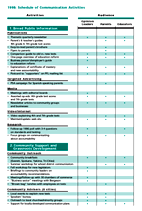 In 1989 the US Business Roundtable (BRT) began a major ten year campaign “to reform the entire system of public education”. Its school reforms were promoted in the name of international competitiveness. The BRT argued that “too many students were leaving school unprepared for productive work and effective citizenship”.
In 1989 the US Business Roundtable (BRT) began a major ten year campaign “to reform the entire system of public education”. Its school reforms were promoted in the name of international competitiveness. The BRT argued that “too many students were leaving school unprepared for productive work and effective citizenship”.
The BRT claimed that school graduates “arrive at our doors unable to write a proper paragraph, fill out simple forms, read instruction manuals, do essential mathematical calculations, understand basic scientific concepts or work as a team”.
Roundtable members enrolled state governors and business leaders in each state to push for “standards, rigorous assessments and accountability” in schools. According to Emery and Ohanian, “Governors fell over each other rushing to adopt this corporate agenda.” (see National Summits)
 In 1998 the BRT launched its “Keep the Promise” Public Awareness Campaign in conjunction with the NAB, the Advertising Council, the American Federation of Teachers, the National Governors Association and the US Department of Education, with funding from the Annie E. Casey Foundation and the Pew Charitable Trusts. This national advertising campaign placed $250 million worth of “public service” advertisements in the media to get the public to support the business campaign for standards and testing in public schools.
In 1998 the BRT launched its “Keep the Promise” Public Awareness Campaign in conjunction with the NAB, the Advertising Council, the American Federation of Teachers, the National Governors Association and the US Department of Education, with funding from the Annie E. Casey Foundation and the Pew Charitable Trusts. This national advertising campaign placed $250 million worth of “public service” advertisements in the media to get the public to support the business campaign for standards and testing in public schools.
The extent of the BRT public relations communications planned in 1998 to build support for high stakes standardised testing can be seen by clicking the schedule to the left.
The BRT pointed out that standards were required to be met in other realms of life, particularly business, so why not schools? According to the BRT: “Standards are explicit statements that describe the skills and knowledge that all students must achieve and the level at which they must achieve them.” Testing allowed schools to measure student progress towards meeting those standards and enabled others to hold schools and teachers and the students themselves accountable when students did not achieve the standards.
BRT aimed to “dramatize the urgency of the need to raise standards in America’s public schools”. But what BRT actually did was to conflate the idea of a high standard education with the idea of standard content in curricula. It constantly referred to standards as “high academic standards” whereas what it really wanted was for the content of school education to be more standardised across the nation so it would cover a narrow range of knowledge and skills that business leaders thought was necessary for employees, and for that standardised content to be reinforced with tests.
 BRT not only lobbied to get standards and associated testing into schools, but it actually sought to influence those standards and therefore determine what was being taught in schools. It urged business people to “participate on committees that determine the types of tests (or test questions) used and the standards of proficiency (how good is good enough)” to make sure that tests “are both rigorous and relevant”. “Setting standards, we believe, is business leaders’ most important opportunity to act on their dissatisfaction with the nation’s education system.”
BRT not only lobbied to get standards and associated testing into schools, but it actually sought to influence those standards and therefore determine what was being taught in schools. It urged business people to “participate on committees that determine the types of tests (or test questions) used and the standards of proficiency (how good is good enough)” to make sure that tests “are both rigorous and relevant”. “Setting standards, we believe, is business leaders’ most important opportunity to act on their dissatisfaction with the nation’s education system.”
BRT pointed out in A Business Leader’s Guide to Setting Academic Standards that business people should at least “Make sure the standards are measurable and organized so they emphasize the skills and knowledge you believe are most essential.”
As part of their campaign, BRT members divided up the states between them in order to work with state governors and chief state school officers to reform schools. So for example Boeing’s CEO took on Washington, whilst the CEOs of Lockheed Martin, Potomac Electic Power Company and Citigroup took on Maryland, forming the Maryland Business Roundtable for Education (MBRT) for the purpose.
Soon, it seemed no area of school life was beyond corporate scrutiny or without business involvement. Corporations helped train teachers and administrators, offered scholarships to deserving students, provided instructional materials, subsidized school programs, and cosponsored the activities of professional organizations. Businesspeople toiled as tutors, served as mentors, and offered their organizational knowledge to schools willing to learn the lessons of the corporate management ‘revolution’.
 Yet despite all this business involvement, funding of schools remained inadequate. Corporations preferred to give small amounts of money through gifts and sponsorships and be seen as benefactors, than to pay the taxes required to fully fund the schools. Alex Molnar, author of Giving Kids the Bu$iness, estimates that the total amount donated by corporations to US schools would run the schools in the US for less than two hours a year. The supposed largesse of corporations is further reduced by the fact that these donations are generally tax deductible. One US Senator, Howard Mertzenbaum, observed:
Yet despite all this business involvement, funding of schools remained inadequate. Corporations preferred to give small amounts of money through gifts and sponsorships and be seen as benefactors, than to pay the taxes required to fully fund the schools. Alex Molnar, author of Giving Kids the Bu$iness, estimates that the total amount donated by corporations to US schools would run the schools in the US for less than two hours a year. The supposed largesse of corporations is further reduced by the fact that these donations are generally tax deductible. One US Senator, Howard Mertzenbaum, observed:
In speech after speech, it is our corporate CEOs who state that an educated, literate work force is the key to American competitiveness. They pontificate on the importance of education. They point out their magnanimous corporate contributions to education in one breath, and then they pull the tax base out from under local schools in the next.
The Business Roundtable (BRT) has also campaigned to extend standardised testing to pre-schools. It argues that providing appropriate pre-school programs for disadvantaged children, which ensure they are ready to learn when they arrive at school, “can significantly reduce teen pregnancy, poor school performance, dropping out, criminal activity, and other negative and expensive behaviours in later years”.
The BRT joined with Corporate Voices for Working Families (CVWF), another corporate coalition, in a campaign that argued for children in preschool to be taught English language literacy and numeracy and for state pre-school curriculum standards aligned to standards in the early grades of schools. The toddlers should have their learning progress measured to ensure that preschools are accountable and there should be “incentives for meeting or exceeding objectives as well as consequences for persistent failure to achieve intended outcomes for children”.
The Committee for Economic Development (CED) has also been advocating preschool being made freely available for all US children from three years old. Its 2006 report on the subject was subtitled “Using Early Education to Improve Economic Growth and the Fiscal Sustainability of States and the Nation” showing its belief that early education would contribute to economic growth. It claims that preschool care not only improves the employment prospects of children later in life but reduces the chances they will turn to crime: “For every dollar spent on preschool, states are projected to recoup 50 to 85 cents in reduced crime costs and 36 to 77 cents in school savings.”
Similarly the 2006 report of the New Commission on the Skills of the American Workforce, Tough Choices or Tough Times, called for high-quality universal preschool for children from the age of 3 as a necessary requirement for ensuring children are ready for school.
If you have any examples or updates you would like to contribute please email them to me and I will add them here. Please give references for where you sourced the information.